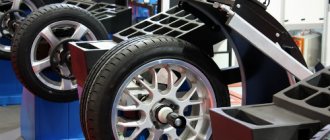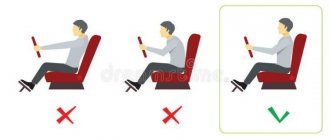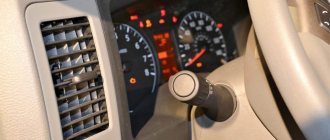September 19, 2016 Lada.Online 34 303 2
One of the first Lada Vesta sedans went to Autoreview, where it is undergoing endurance tests. To date, the car has undergone 30,000 km of serious testing, which is equivalent to 100,000 km of daily mileage or 5 years of operation (in addition to the heavy load on all vehicle systems, there were corrosive loads). We'll tell you what breakdowns, sores and shortcomings await owners over such a period of time.
Gluttonous 1.8 engine
The original 122-horsepower 1.8 unit, which had been reaching production cars for a long time, was disappointing in 3 ways: it turned out to be not very vigorous, and also greedy for fuel mixture and oil.
Car owners will have to come to terms with gasoline consumption in toffees exceeding 10 liters. But after upgrading the engine, we managed to get rid of two other problems.
To improve traction characteristics, engineers dug into the firmware. And to eliminate the oil burn, large-scale modifications to the hardware and assembly procedures were carried out.
Newsies have begun to complain less frequently, but individual episodes of increased oil consumption still occur.
Read - what kind of oil to pour into the Lada Vesta engine.
About spare parts
- Prices from official dealers are not the same, but may differ several times. For example, a set of front brake pads can cost from 1,500 to 3,800 rubles at different dealers.
- The most expensive spare part was the muffler - 11,000 rubles.
- Almost all spare parts for Vesta have to be purchased to order and wait on average 1 month.
Show/Hide text
| Costs for a Lada Vesta car | ||
| Mileage, km | What was spent on | Amount, rub. |
| 3500 | Wheel cap | 100 |
| 6375 | Brake pads | 2420 |
| 7930 | Exhaust system mounting support | 50 |
| 10020 | Exhaust system mounting support | 50 |
| 10020 | Brake pads | 1950 |
| 10100 | Wheel cap | 100 |
| 11790 | TO-1 (oil, oil filter) | 2800 |
| 12580 | Engine plastic cover retainer | 110 |
| 15850 | Brake pads | 1950 |
| 16260 | Wheel cap | 100 |
| 18320 | Exhaust pipe | 11300 |
| 20300 | Exhaust system mounting support | 50 |
| 23250 | Muffler suspension | 200 |
| 23750 | TO-2 (oil, oil, air, cabin filters, spark plugs) | 5500 |
| 25520 | Rear shock absorber | 3100 |
| 25600 | Antenna | 4500 |
| 26000 | Rear shock absorber | 3100 |
| 26800 | Rear suspension beam silent blocks | 1220 |
| 27600 | Brake pads | 1950 |
| 30300 | Wheel cap | 100 |
| 31200 | Wheel cap | 100 |
| 31500 | Heater radiator (complete with heater) | 19000 |
| 31800 | Release bearing | 4450 |
| 31800 | Secondary shaft bearing | 1450 |
| Topping up engine oil (for the entire period) | 320 | |
| Total for maintenance and repairs | 67920 | |
| other expenses | Tires (4 sets) | 44000 |
| Gasoline AI-95 (average consumption 12.3 l/100 km) | 145630 | |
| Total expenses | 257550 | |
Knocks in the suspension
In general, West levers last quite a long time. Extraneous noise may come from shock absorbers and stabilizer struts. The latter, by the way, sometimes did not live to reach 10 thousand km. Over time, the plant produced improved parts.
It is worth noting that car dealers agree to replace shock absorbers only in the case of clearly visible oil leaks. If the noise-producing elements are dry, the owner may be refused repairs.
Two Russians and one French
It means that under the hood of the Lada, two Russians and a Frenchman meet. The first small one, named VAZ-21129 (1.6, 106 hp) was old, known to everyone, time-tested and modified several times. Therefore, due to the experience he has gained, he takes his “bride” quickly, but lives long and peacefully. It happens, of course, that in hot weather it won’t start the first time, the pump will leak, the radiator needs to be flushed before summer, and the ill-fated manifold tube needs to be changed on time, but the overall resource is in perfect order. Travels at least two hundred thousand.
The second, VAZ-21179 (1.8, 122 hp) turned out to be young and strong, but at the same time, as often happens with people, stupid in the head, both in the literal and figurative sense. Literally it means that the engine had a real problem with the standard firmware of the “brains”, which the dealers fixed under warranty; in the figurative sense, the engine was drinking and is still drinking its own blood, that is, it suffers from a currently incurable oil burn. Complete replacement of the unit does not help. No matter how many diagnostic doctors examined the patient, there was only one diagnosis - such a design. That is, it drives and that’s fine. As a temporary measure, the manufacturer suggests increasing the oil viscosity. They promised to fix the problem in 2019, but we’ll see about that.
I would like to believe that 1.8 still got rid of the oil burner
In our area they know firsthand about the “French” H4M (110 hp), along with its “sores” based on the Renault Logan model. Sometimes a chain motor suffers from Parkinson's, which is treated by replacing the left motor mount. Sometimes the “old man” starts whistling for no reason, which means tighten the belt on the belt of the mounted units, or change it to a new leather one, just kidding - non-original. Otherwise, there are no questions about the unit and traveling 350 tkm across Rus' is a piece of cake.
Rusting exhaust system corrugation
The short-lived exhaust tract has always been the weak point of the Lad, and Vesta is no exception. Corrugation rusts very quickly. For some time this does not appear in any way. However, after about 40 thousand km, the timbre begins to change, and in the end the “swallow” with the roar of a fighter has to go for repairs.
Previously, the production warranty was only 1 year or 35 thousand km. But now the domestic manufacturer is ready to replace the failed device within 3 years of operation (100 thousand km).
And on little things...
Some of the disadvantages of the Lada Vesta listed below can be attributed to nit-picking and not to serious shortcomings, but they still exist and create inconvenience for car owners:
- narrow pedal assembly;
- insufficient rear visibility;
- frequent malfunctions of the heated windshield;
- excessive sensitivity of ABS fails;
- no lock on the gas tank cap
- Incomprehensible operation of the central locking.
In general, eliminating factory defects for AvtoVAZ is one of the priority tasks in the policy of improving product quality. It is important for consumers to contact their personal managers in a timely manner not only with serious problems, but also with minor defects, thus making their contribution to the elimination of factory defects by the plant.
Turn signals not working
Turn doublers made of LED elements, built into the exterior mirror housings, turned out to be short-lived. At first, they were deprived of tightness and died from water getting inside, and later without the participation of moisture.
There are no problems with warranty repairs.
Now this problem is much easier to treat than it was at the start of sales. If previously it was necessary to change the entire mirror in a long and tedious manner, now only the optical elements are changed. If the warranty period has already passed, replacing the LEDs will cost 500 rubles.
Electronics and its 5 disadvantages
The quality of the electronics is also disappointing. AvtoVAZ should seriously pay attention to such disadvantages as:
- poor clarity and contrast of the picture on the MMC display;
- Vesta owners complain about rearview cameras turning off while operating in AUX mode;
- interruptions in operation, weak connection with Bluetooth, freezing, after which you need to do a Hard Reset;
- sometimes the heated glass breaks due to firmware or fuses;
- A common problem is a broken ignition coil, which will actually be replaced under warranty.
Vesta has an electronic gas pedal. As car owners say, the electronic pedal fails. This is most likely due to a lack of mechanical connection between the pedal itself and the throttle body. There were precedents, the car refused to move (you press the gas, but nothing happens). The electronic pedal brakes.
Unreliable outdoor antenna
Vesta is equipped with 2 types of antennas for the standard multimedia system:
- Regular.
- In the form of a shark fin (on the “cross” and “sport” versions).
The first type is characterized by a defect - during operation, the body disassembles itself. The upper part flies off while moving. On the latest releases, only fin antennas are installed.
Engine mount knocking
The third malfunction that may make itself felt is the right engine mount. It may knock or squeak when moving. What could be wrong with her? When moving, the support dampens transverse vibrations transmitted to it from the engine. The central part has a degree of mobility.
The gap between the side walls and the central part should not exceed 2 mm. Otherwise, extraneous sound will be heard. At the first appearance of knocking, lubrication of the side walls of the support helps.
Lada Vesta salon
We move smoothly from the body to the interior design of the sedan. Once inside the car, you immediately notice that the plastic is not of the highest quality and is durable, of which there is an abundance inside. If the car already has a mileage of 15-20 thousand kilometers, then at times you can hear creaks and crickets of component parts, which indicates that the quality of the seals is not high enough. Also, in their reviews, car owners often complain about the steering wheel pad - it quickly wears out and loses its original appearance.
Read The Audi SQ2 crossover from ABT has significantly increased its output
Of course, making complaints about the quality of finishing materials in the interior of a car, the price tag of which barely exceeds the mark of 500,000 rubles, is a thankless task. You won’t find Alcantara or leather inside (although eco-leather is available in the top-end configuration). The most serious “disease” of the Lada Vesta in the cabin is multimedia. Owners complain en masse about “glitches” and system freezes; often the radio does not turn on at all - only a “hard reset” helps.
The rest of the owners' complaints about the interior boil down to the following:
- the instrument panel is not well detailed - the indicators of some sensors are not so easy to read, you have to peer at them, which at times interferes with driving;
- the view of additional instruments is completely obstructed by the steering wheel;
- The CityGuide navigation system does not work correctly (over time, the manufacturer eliminated this problem).
When you connect a phone or after switching to the “AUX” mode in the menu, the rear view camera often stops working and Bluetooth turns off spontaneously. But with all this, we note that all these shortcomings were clearly noticeable even in the first batches of the car. In addition, glitches can be eliminated by changing the firmware. In all other respects, the interior of the Lada Vesta can be given a positive assessment of the level of comfort: comfortable seats, an armrest for the driver and a steering wheel.
Four minus one
What is completely unusual for the Lada Vesta is the fact that the line of units includes three engines and four different gearboxes with their own pros and cons and, what is even more interesting, three manual gearboxes and only one automatic, the well-known AMT. This is where we will begin our review of the weak points of the transmission.
It will not be a revelation to anyone that we don’t like “robots” for a reason. There are significant, sometimes very capacious in terms of the amount of swearing, reviews from the owners. And it doesn’t matter who developed the box, the Germans or the Japanese, there is only one conclusion - they are still far from ideal. This is especially true for the relatively cheap AMT with one clutch, which, in fact, was equipped with the budget Lada Vesta.
It was not just anyone who worked on the Vesta clutch, but Sachs himself!
In short, the automatic transmission of the model consists of a VAZ gearbox, onto which the German ZF shift mechanism and Sachs clutch are “strung”. It's terribly stupid. It jerks, hangs on an unnecessary gear, or, on the contrary, shifts too early - all this is typical for a mechanism that cannot and will not learn to read your thoughts in the next decade.
Another “robot” under repair
If we add to all this the driver’s passionate disposition and refusal to periodically adapt the grip point, we get early clutch wear and, less often, worn-out synchronizers. Depending on the careful driving, clutches last an average of 80 tkm. Replacing the basket costs a little more than 15 thousand rubles, which is considered cheap for a “robot” and at the same time expensive for the owner of a Lada car. It’s easy to understand that the clutch is worn out - the car starts to shake like a “groove” when starting from a standstill and when switching.
Robot actuator under repair
The three remaining manual transmissions have almost no problems. Even the VAZ gearbox, mated only to the unit with the lowest horsepower, turned out to be reliable, although it was not distinguished by silence and clarity of operation. French gearboxes vibrate less and are better at selecting speeds, but they still howl, be it JH3, installed on the same motor, or JR5, mated to two more powerful units.
Transmission noise
A noise is heard from the gearbox, a small knock that disappears when you press the clutch pedal.
There are 2 misconceptions:
- The release bearing hummed. But it shows itself only at the moment the pedal is pressed, when the load on the clutch bearings begins.
- The input shaft bearing is humming. This is also incorrect, since SKF bearings have been installed on VAZ boxes for many years. There is practically no marriage on them.
In fact, the culprit of the knock is the clutch driven disc, namely its central bushing.
It has play in the seat. During torsional vibrations at idle, a fractional knock appears. The problem is solved by installing new clutch discs.
But you are probably more interested in something else - how does the most beautiful version of Cross drive?
Already in the base there are 17-inch wheels, large by the standards of the class, 203 mm ground clearance and other springs and shock absorbers. You could have waited for anything, but the people from AvtoVAZ took the medical “do no harm” as a basis and did everything to ensure that the driving character of the Vesta did not deteriorate. And they succeeded in this!
The approach angle of the Lada Vesta SW Cross is 18.1 degrees, and the departure angle is 17.7 degrees.
Moreover, the Lada Vesta SW Cross feels even more lively and interesting than the base sedan! Feedback on the steering wheel is more transparent, the chassis is still tenacious and collected, and the suspension, despite the additional load in the form of 17-inch wheels, still perfectly handles bumps and road surface defects of almost any scale.
These beautiful two-color discs covered joints of concrete slabs, giant asphalt patches, gravel, large stones with sharp edges, and sewer manholes. And nothing! On small things, peace and comfort reign in the car, and on more serious defects, the body may shudder, but without hard impacts, unnecessary noise and frightening consequences.
Of course, Vesta SW Cross is not a car without flaws. The 1.8 engine is still just as sluggish, and the hard plastic on the door armrests will still rub the elbows resting on them. But “Cross” masterfully knows how to hide all this behind an excellent design, high ground clearance, which some crossovers would envy, and an excellent chassis. And in Russia, as a rule, they ask for something like a million or more.
But rules are meant to be broken, right? Therefore, prices for a regular station wagon start at a reasonable 639,900 rubles for a car with a 106-horsepower 1.6 and a manual transmission. For 25,000 rubles on top, the car will be equipped with a robot. A modification with a 1.8 engine costs at least 697,900 rubles, and with a 1.8 and two pedals – from 722,900 rubles.
The cross version is naturally more expensive. For the minimum configuration they will charge 755,900 rubles. It will be a car with 1.6 and mechanics, but with front and side airbags, an alarm system, an on-board computer, remote control central locking, electric windows all around, climate control, heated front seats, light and rain sensors, electric drive and heated mirrors, cruise -control and 17-inch wheels.
The most expensive Lada Vesta SW Cross costs 847,900 rubles. That is, AvtoVAZ made a B-segment car, which even at the top did not reach 900,000 rubles. In our time this is an achievement.
The interior architecture of Vesta SW and SW Cross is the same as that of the sedan. But there are new decorative inserts (on the Cross version), which look much better and more organic than those of the sedan
There are orange accents on the dashboard as well. It has become brighter, but I still want the shield to be simpler. Too many unnecessary design elements
Bright interior trim is available only in the Cross version. But if someone wants a station wagon with a higher ground clearance, but with a slightly less cheerful interior, then they will be offered gray upholstery











